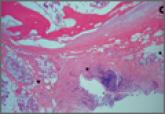Article

Osteochondroma With Contiguous Bronchogenic Cyst of the Scapula
- Author:
- Edelstein AI
- Linn RL
- Fritsch MK
- Sagan M
Osteochondroma is a benign bone tumor composed of a bony protrusion with an overlying cartilage cap. Osteochondromas arise in the scapula in 3% to...
